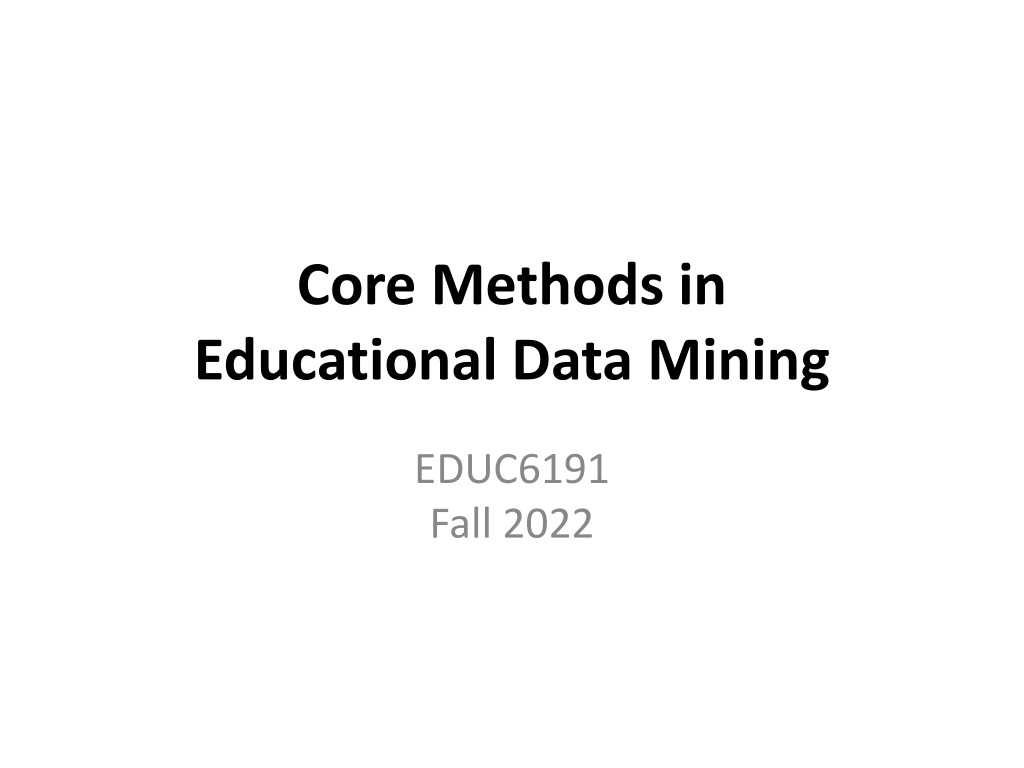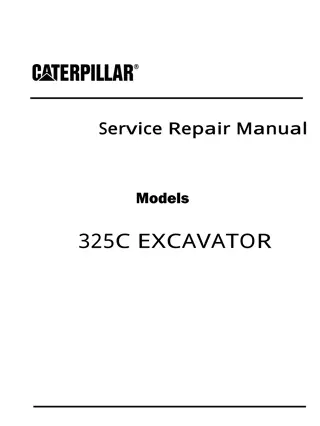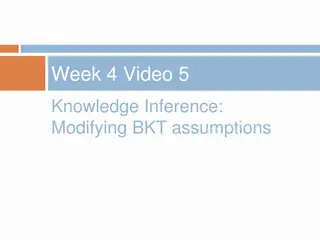
Methods in Educational Data Mining & Knowledge Inference
Explore the world of Educational Data Mining with a focus on Epistemic Network Analysis, successful/unsuccessful team processes, and knowledge inference goals, all within the educational setting. Dive deeper into understanding student knowledge and the utility of measuring it. Discover more about ENA and its applications for educational research.
Download Presentation

Please find below an Image/Link to download the presentation.
The content on the website is provided AS IS for your information and personal use only. It may not be sold, licensed, or shared on other websites without obtaining consent from the author. If you encounter any issues during the download, it is possible that the publisher has removed the file from their server.
You are allowed to download the files provided on this website for personal or commercial use, subject to the condition that they are used lawfully. All files are the property of their respective owners.
The content on the website is provided AS IS for your information and personal use only. It may not be sold, licensed, or shared on other websites without obtaining consent from the author.
E N D
Presentation Transcript
Core Methods in Educational Data Mining EDUC6191 Fall 2022
Epistemic Network Analysis Is anyone here familiar with ENA? What is it?
Epistemic Network Analysis Is anyone here familiar with ENA? What is it? Studying relationships between elements in coded data
Studying Process of Successful and Unsuccessful Teams (Arastoopour et al., 2016)
Studying connections between topics in meetings over time (Nash & Shaffer, 2013)
Has anyone here conducted an ENA? If so, please tell us about it
To learn more about ENA EDUC5100 Quantitative Ethnography
Basic Assignment: SNA Any questions? Comments?
What is the Goal of Knowledge Inference?
What is the Goal of Knowledge Inference? Measuring what a student knows at a specific time Measuring what relevant knowledge components a student knows at a specific time
Why is it useful to measure student knowledge?
Key assumptions of BKT Assess a student s knowledge of skill/KC X Based on a sequence of items that are scored between 0 and 1 Classically 0 or 1, but there are variants that relax this Where each item corresponds to a single skill Where the student can learn on each item, due to help, feedback, scaffolding, etc.
Key assumptions of BKT Each skill has four parameters From these parameters, and the pattern of successes and failures the student has had on each relevant skill so far We can compute Latent knowledge P(Ln) The probability P(CORR) that the learner will get the item correct
Key assumptions of BKT Two-state learning model Each skill is either learned or unlearned In problem-solving, the student can learn a skill at each opportunity to apply the skill A student does not forget a skill, once he or she knows it
Model Performance Assumptions If the student knows a skill, there is still some chance the student will slip and make a mistake. If the student does not know a skill, there is still some chance the student will guess correctly.
Classical BKT p(T) Not learned Learned p(L0) p(G) 1-p(S) correct correct Two Learning Parameters p(L0) problem solving. Probability the skill is already known before the first opportunity to use the skill in p(T) Probability the skill will be learned at each opportunity to use the skill. Two Performance Parameters p(G) Probability the student will guess correctly if the skill is not known. p(S) Probability the student will slip (make a mistake) if the skill is known.
Parameter Fitting Picking the parameters that best predict performance on next attempt Any questions or comments on this?
Overparameterization BKT is thought to be overparameterized (Beck et al., 2008) Which means there are multiple sets of parameters that can fit any data
Degenerate Space (Pardos et al., 2010)
Parameter Constraints Proposed Beck P(G)+P(S)<1.0 Baker, Corbett, & Aleven (2008): P(G)<0.5, P(S)<0.5 Corbett & Anderson (1995): P(G)<0.3, P(S)<0.1 Your thoughts?
Does it matter what algorithm you use to select parameters? EM better than CGD Chang et al., 2006 CGD better than EM Baker et al., 2008 A = 0.05 A = 0.01 EM better than BF Pavlik et al., 2009 Gong et al., 2010 Pardos et al., 2011 Gowda et al., 2011 BF better than EM Pavlik et al., 2009 Baker et al., 2011 A = 0.003, A = 0.01 A = 0.005 RMSE= 0.005 A = 0.02 A = 0.01, A = 0.005 A = 0.001 BF better than CGD Baker et al., 2010 A = 0.02
Are these the same thing? Predicting performance on next attempt Inferring latent knowledge
What are some alternate ways to assess Whether a model is successful at inferring latent knowledge
What are some alternate ways to assess Whether a model is successful at inferring latent knowledge Why aren t those approaches used more often?
What are some possible uses of BKT? Both the P(Ln) estimates And the other parameters it produces
BKT: Extended uses Conditionalizing P(T) Does help help? (Beck et al., 2008) Which content is most effective? (Baker et al., 2018)
BKT: Extended uses Moment-by-moment learning estimation (calculating P(T) in specific step) Which moment-by-moment learning curves are associated with more robust learning? (Baker et al., 2013) What behaviors predict eureka moments (Moore et al., 2015) Which types of content are associated with more learning? (Slater et al., 2016)
BKT: Extended uses Detecting carelessness (contextual slip) (calculating P(S) in specific step) Predicts test score (Pardos et al., 2014), college enrollment (San Pedro et al., 2013), job several years later (Almeda & Baker, 2020)
BKT: Extended uses Transfer assessment (adding P(T) from other skills) Used to study relationship between skills (Sao Pedro et al., 2014) Including in graduate students learning research skills across several years (Kang et al., 2022)
Next Classes October 20 Association Rule Mining and Sequential Pattern Mining (Valdemar) BA4 due October 27 Logistic Knowledge Tracing BA5 due November 3 Text Mining (Valdemar) BA6 due



